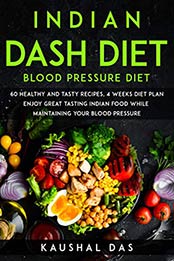
- Title: Indian DASH diet: 60 healthy recipes with pictures, 4 weeks diet plan (Indian Health Diet)
- Author: Kaushal Das
- Pages:
- Publisher (Publication Date): September 30, 2020
- Language: English
- ISBN-10: B08KH4RQQ7
- Download File Format:EPUB
In 2012, I wrote a book which is available on Kindle entitled, Healthy fusion Indian Soups Salads and Snacks. At the time, my need simply was to create recipes and meals which were healthy but not bland. Naturally, I also wanted to preserve my Indian flavors as much as possible.
Now that I am little older, I am focused on good health. Monitoring and maintaining normal blood pressure and sugar levels is becoming my primary goal. I decided to research the kind of diets that will help me in achieving my goal. We all know that eating salad and baked vegetables are very good for us; however, experience has shown, that for most folks, that diet is difficult to sustain. We are hardwired to follow our own habit which is especially true for food.
This book reflects my quest for maintaining hypertension or blood pressure (used interchangeably in this book) while still preserving natural Indian taste and flavor as much as possible.
The audience of this book can be anyone who loves Indian food and is also trying to maintain a healthy blood pressure level. The diets presented in this book should help you do just that; however, I am not a doctor, and this should not be considered medical advice. Blood pressure a serious disease, and only a qualified physician is able to diagnose or treat it.
My intent is not for you to use this book in any way to replace advice or recommendations of a qualified doctor. In exploring recipes that may help you maintain a normal blood pressure, I referred to medical journals and sites for selecting ingredients and processes for the recipes. Additionally, I used recommendations by the Mayo Clinic and Harvard Medical School wherever appropriate.
While Indian foods are known to be flavorful and often vegetarian and healthy, generally they are high in sodium. Extra care should be taken when preparing meals to most normal meals to reduce the sodium contents. This is important due to the fact that the people in South Asian and Indian countries tend to have higher than average risk of blood pressure, diabetes, and heart disease. It is essential for them to maintain a healthy blood pressure level.
In order to assist others in their quest for healthier eating, my approach in organizing the book consisted of two steps. First, I identified dishes that were generally healthy and had low sodium contents. Next, after shortlisting those dishes, I altered them in order to incorporate ingredients that were recommended by the Mayo Clinic / Harvard Medical School to enhance the nutritional value as well as reduce the sodium contents. The combination of the two steps resulted in simple, traditional Indian foods that are low in sodium.
It is my hope that this book will help you in your quest to maintain a healthy blood pressure level while still enjoying delicious Indian food.
![Dash Diet Air Fryer Cookbook by Brarn Shaone [EPUB: B08KR97782] Dash Diet Air Fryer Cookbook by Brarn Shaone](https://cookebooks.info/wp-content/uploads/2020/11/B08KR97782.jpg)
![The Soups and Snacks of India by Rekha Sharma [EPUB: B086YYZSQP] The Soups and Snacks of India by Rekha Sharma](https://cookebooks.info/wp-content/uploads/2020/04/B086YYZSQP.jpg)
![DASH DIET MEAL PREP by Eva Evans [EPUB: B08L89X3HJ] DASH DIET MEAL PREP by Eva Evans](https://cookebooks.info/wp-content/uploads/2020/11/B08L89X3HJ.jpg)
![DASH DIET COOKBOOK by MARIE BLANCHARD [EPUB: B08M6FFR9F] DASH DIET COOKBOOK by MARIE BLANCHARD](https://cookebooks.info/wp-content/uploads/2020/11/B08M6FFR9F.jpg)
![The Indian Way - Soups, Snacks & Salads by Sushma Nambiar [EPUB:B093JS9HPT ] The Indian Way - Soups, Snacks & Salads by Sushma Nambiar](https://cookebooks.info/wp-content/uploads/2021/06/B093JS9HPT.jpg)
![Rediscovering Healthy Eating With 101 Indian Instant Pot Recipes by Sherry Heckert [172558669X, Format: EPUB] 172558669X](https://cookebooks.info/wp-content/uploads/2018/09/172558669X.jpg)